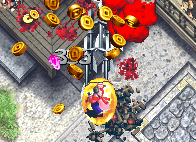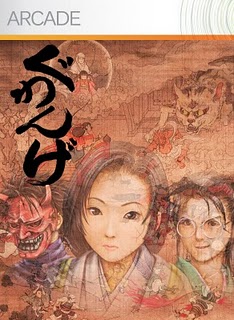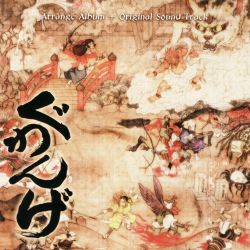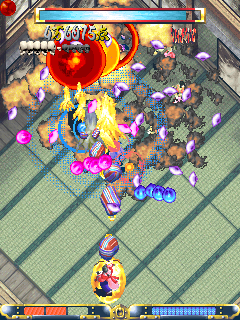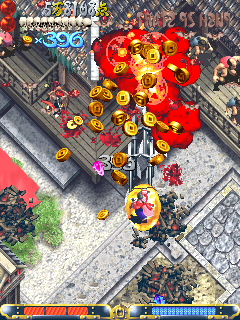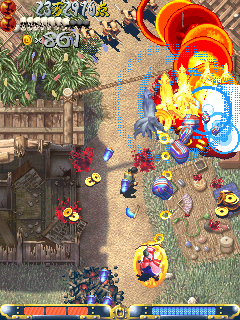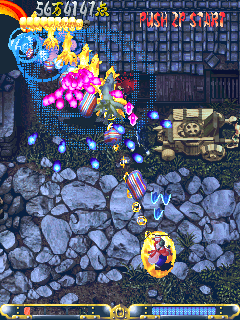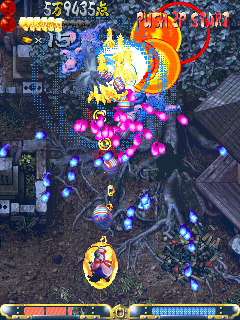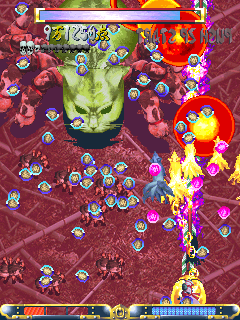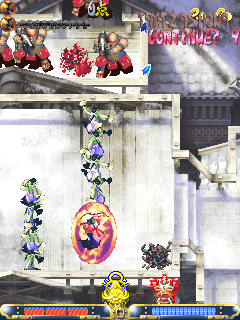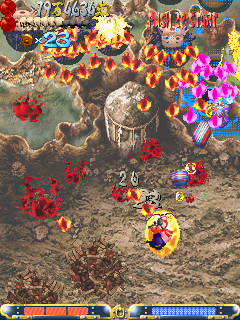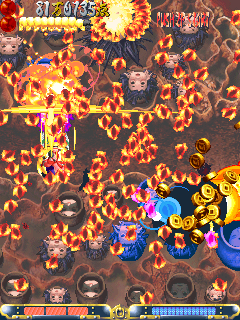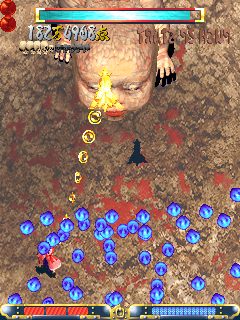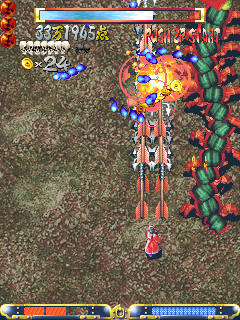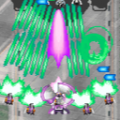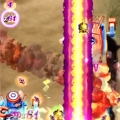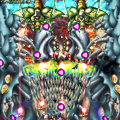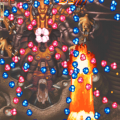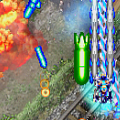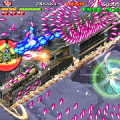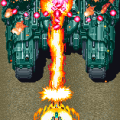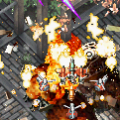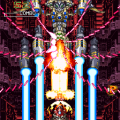by Andrew K – March 26, 2011
Japanese game developer Cave, though still extremely obscure to a majority of casual gamers out there, has slowly turned itself into a household name as far as fans of the 2D scrolling shooter subgenre is concerned. Rarely releasing a non-shooter title since their debut of DonPachi in 1995, Cave is viewed by many to have all but perfected this subgenre. Cave continues even today to produce fun, action packed titles using essentially the same tried and true gameplay formula they’ve utilized since the beginning, constantly tweaking aspects and experimenting with new mechanics to give each new title a unique feel of its own. This approach allows them to continue to release surprisingly fresh and entertaining titles, even in a subgenre considered obsolete by many.
Guwange, released in Japanese arcades by Cave in 1999, strays away from Cave’s usual tendency toward science fiction/post-apocalyptic settings, and instead takes place in feudal Japan. The plot involves people becoming possessed by spiritual beings called shikigami, which bestow upon their host great spiritual powers but kill them after a year. Three of those possessed (with the help of their shikigamis) each seek to purge this horrible outbreak by infiltrating Mount Gokumon and murdering the titular Guwange, the evil god which resides within and the assumed source of the devilish plague. In order to accomplish this however, they must first acquire five elemental scrolls held by five of Guwange’s demonic underlings. Go figure, right?
Characters
Shishin
Age: 35
Weapon: Kunai
Shikigami: Rikiou
Shishin seeks to hunt down Guwange, being informed by a goddess that doing so will not only free him of the shikigami which plagues him, but will also restore to him his long-lost daughter Mikoto. Having made a deal with his shikigami Rikiou, Shishin is one of very few shikigami hosts to survive over a year. In exchange for killing humans which Rikiou devours, the shikigami has taken efforts to keep him alive. Wearing the frightening mask of an Oni (a Japanese demon or monster) and maintaining a silent demeanor, rumors of him as a man-eating ogre have begun to spread amongst the commoners.
Hiiragi Kosame
Age: 17
Weapon: Bow and arrows
Shikigami: Yatsuhisha
Coming from a long line of demon-hunters, Kosame seeks to destroy Guwange under orders of her father, who wishes her to exercise the shikigami, Yatsuhisha, from herself. Fortunately for Kosame, Yatsuhisha, who took possession of her during a battle with demons, was raised by a demon with sympathy toward humans. As such, the shikigami considers Kosame a close personal friend and would help and protect her, even at the cost of his own life.
Kamono Gensuke
Age: 15
Weapon: Swords
Shikigami: Kirinmaru
A pharmacist in training, Gensuke wishes to destroy Guwange simply to rid himself of the vicious shikigami Kirinmaru, who had possessed him in order to fulfill a grudge held by the shikigami against his family. Gensuke has taken up bounty hunting in the meantime, in an attempt to channel the violence of the shikigami away from innocent people.
Each character has their own style of attack, allowing players to choose whichever one suits their playing style best. Hiirage fires her arrows in a strong concentrated straight shot, useful for eliminating single enemies faster. Kamono hurls his swords in a wider spread-out pattern, useful for dispatching more enemies at once. Shishin throws his kunai in a straight line with the direction changing depending on which way the character is moving, useful for… to be honest, pretty much nothing. Guwange tasks you with guiding one of these three characters through six dangerous stages of hectic bullet-riddled action.
Instead of the usual lives system usually found in shooters, Guwange provides its characters with three separate life bars, similar to the system used in the Shikigami no Shiro series. This proves to be both beneficial and detrimental to the player. On one hand, players can usually take around two to three hits before a life bar is depleted, which is more forgiving than the one-hit kills that are usually a given in Cave games. Unfortunately, with the maximum number of life bars set at three from the beginning, the player is prevented from hoarding lives over the course of the game. Health restores are strewn throughout the stages, rather than being obtained through scoring. In addition, players are provided with two screen-clearing bombs in case of an emergency, more of which can be obtained throughout the game. It should also be mentioned that, unlike many of Cave’s shooters, this game ends upon completion, rather than looping back to the beginning for a second run.
On the surface, the gameplay is classic shooter fare, with victory depending on lightning-quick reflexes and the ability to delicately maneuver through the vast amounts of bullets which constantly fill the screen. However one aspect greatly differentiates this title from its shooter brethren – rather than giving players the open sky to play in, Guwange keeps its characters grounded as they march through the carnage toward their destination entirely on foot. This essentially adds a whole new layer of challenge, in that players must not only dodge their way through wave after wave of imminent death, but must do so while being obstructed by buildings, walls and various other objects. Indeed, for every gamer that complains that danmaku shooters lack traditional level design, this proves to be an exception. The scrolling is also slower than a typical Cave game, and the camera often slowly shifts in different directions, forcing the player to navigate through some extremely tight corridors. In addition, some of these objects can actually obstruct gunfire from the characters’ primary attacks. From a gameplay standpoint, it makes an already difficult task even more of a headache.
Any Cave enthusiast knows, however, that for every heavy burden placed upon players’ shoulders, an ability is always provided to help balance the odds – a shining path to victory for the players who possess the skill and constitution required to claim it. This secret weapon manifests itself this time around in Guwange‘s main feature: the shikigami. While quickly tapping the attack button releases the characters primary attack in a constant stream, holding the button down allows players to summon and take control of the character’s spiritual possessor. When the button is released, the shikigami disappears and the player resumes control of the main character. It is the skillful and precise alternation between control of the main character and shikigami which is the key to survival in this game, as the main character is left defenseless and with very limited movement when the shikigami is summoned. The character can still move in sync with the joystick as you control the shikigami, but only side-to-side, and their movement is slowed down as well.
Once summoned, the shikigami is controlled by the player for as long as the attack button is held down. It is invulnerable and automatically attacks anything in its vicinity while providing many benefits to the player which are integral to success. Shikigami, unlike the human character, cannot be obstructed by any object and can travel freely around the screen. This allows the player to not only defeat enemies otherwise protected by obstacles, but enables them to reach otherwise unreachable powerups. Secondly, any bullets within the shikigami’s attack range are slowed down almost to a halt. This can be used to create safety-gaps in the large waves of bullets that constantly flood the screen, allowing spaces for the player to slip through and avoid destruction. Finally, and most importantly of all, any bullets caught in the explosion of a destroyed enemy are automatically destroyed. This aspect is especially key to the game’s unique scoring system.
Cave is a developer which seems to pride itself in constantly conceiving original and intuitive scoring systems for each new title they put out, and Guwange is absolutely no exception. When enemies are destroyed they drop coins which (depending on the enemy type) either sit on the ground until collected or float slowly downward off the screen. In addition, when bullets are destroyed by enemy explosions, they are converted into coins which are automatically collected by the main character. The scoring is designed around a combo system which depends on the consistent collection of these coins. The more coins collected in a combo, the higher the score multiplier becomes. The combo count is displayed in the top left corner, underneath a gauge which keeps the combo going as long as it doesn’t time out. Damaging and/or destroying enemies fills the gauge, depending on whether you’re attacking with the primary weapon, or with the shikigami. When attacking with the primary weapon, enemies must be destroyed to increase the gauge, while attacking with the shikigami can fill it by simply damaging enemies as well as destroying them. You can also freeze the combo meter by slowing down bullets with the shikigami. Naturally, the gauge decreases fairly quickly over time when enemies aren’t being damaged or destroyed. When the gauge empties completely, the combo is reset to zero. One aspect of this system which adds another layer of excitement is that, in contrast with the combo systems in many of Cave’s other shooters, combos are not reset at the end of every level, but rather carry over to the next. This creates the potential for skilled enough players to obtain absolutely massive high scores by maintaining combos across multiple levels, but it also can completely ruin a scoring ruin if you make an error.
What really ties everything together from a gameplay standpoint is that the entire game is delicately and deliberately built around the combo system. For practically every gigantic wave of bullets the game throws at you throughout the levels, a group of enemies is provided with which to destroy them with, ensuring survival and racking up the combo. Even the boss fights are littered with smaller enemies or objects to destroy for this same purpose. This ensures that although the game is terrifyingly difficult, it never really feels unfair. Most deaths players will suffer (and there will be many), rather than discouraging players by feeling they were cheated, encourage them to simply try harder the next time. This, combined with the precise and silky-smooth controls that Cave’s games has become known for, ensures that a majority of players, with a bit of effort, will be surprised at the skillful maneuvers they’re able to pull off in a short time. Also in a move that has become trend among Cave shooters, the game pulls its punches for the first two levels; this not only gives the player time to get used to the complex mechanics, but baits them into a false sense of security as well. Naturally, the difficulty ramps up exponentially from level 3 and onward, ensuring that players’ skills are tested to their utmost extent.
The graphics are up to Cave standards, and are likely to be admired by anyone with an appreciation for good sprite-work. The characters and enemies are all animated beautifully, and each character has their own opening and ending cutscenes that, although brief, are done quite stylishly.
Guwange‘s level designs, though rendered very nicely, seem a bit repetetive in comparison with other Cave games. The levels range from Japanese villages, to Japanese temples, to… more Japanese villages. That being said, the designs nicely compliment the setting of the game and the lack of diversity does not detract from the overall gaming experience whatsoever. The aspect in which Guwange‘s graphical design really shines is in its boss characters. The bosses range in design from creative to simply nightmarish. Bosses include a Japanese temple on wheels akin to a tank, a gigantic spider-cat hybrid, and a gargantuan baby straight from the depths of hell that unleashes bullets from the numerous pulsating pustules on it’s back. In short, Guwange presents some boss fights that are likely to linger in players’ minds (or nightmares) even once the game is turned off.
The sound is good overall, and the various explosions and enemy death noises do well in keeping the player immersed in the game. The music, very much like the level design, fit in well with the background of the game, though players will likely not be rushing to add them to their MP3 player anytime soon.
Two separate ports were released for mobile phones in Japan in 2007, one developed for I-Mode, and the other for Yahoo! Mobile. Both were also merged into a single game called Guwange DX, which sported enhanced graphics. Late in 2010, Guwange was released for the first time worldwide as a downloadable port on the Xbox Live Arcade. Visually the game is unchanged, and the gameplay remains intact. Local multiplayer is supported and two additional modes have been added. The first, Arrange Blue Mode, is basically a more challenging version of the original game. The second, Arrange XBOX 360 mode, makes changes which alter the gameplay quite a bit. Rather than switching between control of the character and their respective shikigami, the shikigami is summoned by holding down the R-trigger, and controlled separately with the right analog stick. This allows for the use of the shikigami while retaining the ability to move and dodge the main character simultaneously. In addition, all bullets on screen are slowed when the shikigami is out, and are all converted to coins when any enemy is killed, making for a much easier gameplay experience. Additional enemies are added to attack when the shikigami is summoned, assumedly to balance difficulty, though it really doesn’t make much of a difference. Naturally, score attacks have been added to all three modes, with access to online leaderboards. The original release did not fully support 4:3 monitors in Tate mode, as no matter how you resize the window, it would not fill the whole screen. Fans complained, and this eventually was fixed in a patch.
Overall, this game does all the right things that have become staples among Cave shooters, while integrating enough fresh and intuitive gameplay ideas into it to provide a gratifying and refreshing gaming experience. Even veterans of Cave titles will no doubt be surprisingly immersed in this shooter that, while perhaps not standing up alongside Cave classics such as Dodonpachi or Mushihime-sama, certainly stands alone as one of the most original titles in the subgenre.
